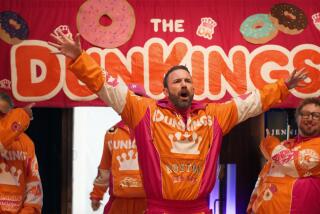It’s Substitution Time on Super Bowl Sunday to Cut Down on Fattening Foods
- Share via
How to Take 20 Pounds Off Your Man: A Lifesaving Guide for the Man You Love, by Suzy Kalter (Pocket: $3.95 paperback, 207 pp.)
Do you nag your mate and point out that he’s pigging out when he overeats during Super Bowl Sunday?
During a recent interview about her book, author Suzy Kalter had a few words of advice for wives on how to handle a Super Bowl-watching mate whose arm is an extension of the refrigerator.
Although Kalter has no formal training in nutrition, she was associated with exercise-health personality, Richard Simmons, and spent seven years as a style editor on the PM Magazine television show. Her advice makes room for naughty foods within a context of knowledge about energy balance and calorie counts.
“Don’t nag,” she said. “Better let him have six beers during the game, but work on cutting down on calories in the next few days to balance out the calories in the beer.
“The Super Bowl is the highlight of a man’s yearly cycle. My husband lives for the day when spring training starts. At our house, Monday night means not taking phone calls, speaking to you or playing with the children during playoffs. It approaches religious fervor. The Super Bowl is a holy day for many men. To deprive someone of their rituals would ruin it for them.”
Worst Eating Day
According to Kalter, Super Bowl Sunday is the worst eating day for men and women. “It’s four long quarters of eating everything that’s fattening and bad for you. But the irony is that most people don’t pay attention to what they’re eating. They just feel compelled to pop something into their mouths for every yard that’s gained or lost.”
Using a little imagination and some of Kalter’s suggestions, one can “fool” the attentive viewer without resorting to obvious diet foods.
It’s wiser, thinks Kalter, for the cook in the house to take some responsibility for their mate’s waistline by learning about calories.
“It’s a matter of making substitutions one enjoys but that have fewer calories than the regular food counterpart,” she said. “People think diet means deprivation. You can eat anything pretty much, but need education about making the right choices.”
So you want to munch on something crunchy during Super Bowl? “There are a zillion kind of things, but only one of them is a smart choice. And that is popcorn,” she said.
Kalter decided to surreptitiously change the family diet and sneak pounds off her husband rather than nag. Reason for the underhanded approach? Men, she thinks, associate diets with denial and therefore resist them.
Her responsibility, she decided, was to trim pounds from her husband. “I thought he was a walking case for General Hospital, a living dare for Heart Attack City,” Kalter explains in her book.
“I know after 10 years of marriage the Super Bowl won’t be satisfying unless he goes to the refrigerator. And I’m not doing veggies or diet. I’m going to have a lot of food in the house, but they won’t be high in calories.”
There will be frankfurters for lunch and turkey for dinner. There are frankfurters that contain no sugar, salt or fat.
“You know it’s been turkey season since Thanksgiving and there’s going to be one more turkey for the Super Bowl.”
There will be doughnuts, too. “Doughnuts are a psychologically complete dessert. A doughnut containes 180 calories, fewer than a piece of cake. It fools you by at least 300 calories. I’m budgeting him for two doughnuts, 100 calories each for two frankfurters and 350 calories for turkey breast and there will be diet sodas, which should take him through a huge hunk of the day.”
For Kalter, the trick is calorie counting and learning the values of foods.
It’s a question of trade-off, thinks Kalter.
“You can expend 100 calories for a chocolate dessert or a bowl of pudding. I’d rather have the pudding, given the choice. But the options are spelled out in black and white. And that’s the value of learning about calories,” she said.
How do you learn? “I did it with a calorie counter guide. There are many different brands around that cost about $3. You’ll be amazed at the different choices in a calorie book.”
Kalter has stepped up the vegetables served to her husband, who is overweight. “I give my husband an entire package of cooked frozen vegetables but little red meat. But rather than say ‘Don’t eat steak,’ I serve it sliced and control the amount served, so there is the satisfaction of eating red meat without the excess calories.”
Here is a suggested menu for Super Bowl Sunday eating to replace typical beer, potato chips, sandwiches with mayonnaise, fried chicken, potato salad, macaroni and slaw, ice cream and chocolate chip cookies:
SUPER BOWL MENU Light beer Open-face sandwich with turkey or chicken, light cheese, tomatoes and diet mayonnaise or mustard Chicken (baked, broiled or barbecued without skin) Cole slaw with low-calorie dressing Ice cream (Weight Watchers brand) or ice milk, frozen yogurt bars, frozen fruit juice bars Plain popcorn Apples, pears, peaches, grapes Kalter doesn’t believe that desserts should be eliminated and thinks the only successful diet is one that doesn’t feel like a diet. She gives a list of foods that drives home the importance of understanding calories in order to widen food choices. This is the list from her book:
--D-Zerta brand chocolate pudding, one serving (1/2 cup)--20 calories
--Fresh cherries, half a pound (that’s a lot of cherries)--107 calories
--Alba brand chocolate milkshake, one cup--113 calories
--Pepperidge Farm brand Bordeaux cookies, three cookies--117 calories
--Banana, one large--119 calories
--Apple, one--123 calories
--Red raspberries, half a pound (serves four)--130 calories
--Baskin Robbins brand mango sherbet, one scoop--132 calories
--Sara Lee brand banana cake, one slice--132 calories
--Chips Ahoy brand chocolate chip cookies, three cookies--150 calories
--Hostess brand chocolate cupcake, one--155 calories.
Kalter points out that the planner must also be aware of the hidden calories in fruits, fruit juices and meats, while looking for “empty calories” (calories that provide little or no nutrition) in foods such as candies, sweets, chips, pretzels, desserts of all kinds, sauces, dressing and toppings, refined flour products, packaged meats and soft drinks.
In the book there are calorie counts for commonly used foods, including alcoholic and non-alcoholic beverages, dairy products, vegetables, fruits, meats, breads, grains and cereals, desserts and miscellaneous condiments.
There are also several recipes and recipe ideas and illustrative menus.
More to Read
Eat your way across L.A.
Get our weekly Tasting Notes newsletter for reviews, news and more.
You may occasionally receive promotional content from the Los Angeles Times.










